Like Father, Like Son: The Art of Daniel and Adam Smith
Daniel and Adam Smith are living remarkable lives. Both are exceptional wildlife artists, and since Adam’s childhood they have shared a strong connection as father and son that only continues to strengthen through their painting. What is remarkable is the genuine friendship between the two and the unshakable—unquestionable—focus each possesses about his work. This focus fuels a discipline that keeps each man at his easel seven days a week.
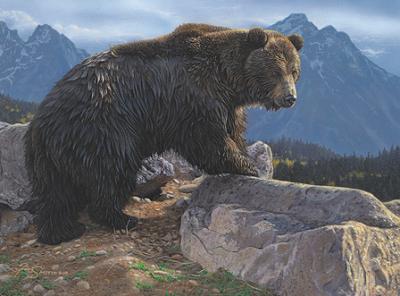
It would be easy for there to be competition between father and son to see who produces the most work, sells the most, or gets in the best galleries. Yet when asked how they decide who will show where, both shrug.
“It doesn’t really come up,” Dan says. Both are sought out by art collectors as well as gallery owners and invited to top shows. Granted, Dan’s work commands higher prices than Adam’s and is included at prestigious museums such as the Eiteljorg Museum of American Indians and Western Art, but, as he says with a smile, “I’ve been doing this for 30 years. I can’t imagine being Adam’s age with the success he has already.”

Dan’s journey into fine art began at age 25, when he realized it wouldn’t happen unless he made it happen. Despite his father’s practical advice to become a dentist because of Dan’s skill with his hands and sensitivity to fine details, Dan chose training in commercial art. His career as an illustrator was going well when he heard the call toward painting. His natural talent quickly merged with his discipline to paint in the evenings and his passion for the wild creatures of the world. Just a few years later, he began winning conservation stamp competitions run by the Federal Duck Stamp program within the U.S. Fish and Wildlife Service. In 1987, his portrayal of a snow goose was selected from a thousand entries as an official waterfowl stamp. The image sold millions of Duck Stamps and thousands of lithographic reproductions, generating millions of dollars for conservation.
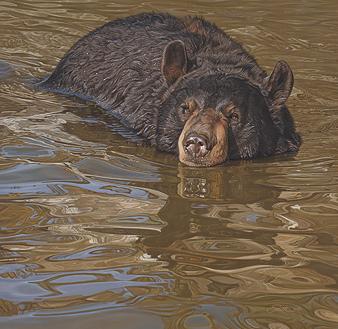
As Dan’s art career flourished, he and his wife, Liz, chose to live in the Rockies to be closer to the wildlife in Dan’s paintings and find a good place to raise their three children. They considered Santa Fe and Durango among other places, but ultimately settled on Bozeman because “the kids liked it.”
Adam, now 26-years-old, was nine when the family scouted the mountain west and decided to make Montana home. He had already picked up the guitar and by the age of 14 was considered a prodigy. Dan and Liz would take their underage son to the Cat’s Paw, a local saloon, so that he could play with the bands. As Dan fondly recalls, even at that age Adam already had followers.
“We were sure Adam would be a musician,” Dan says. “He was really gifted.”
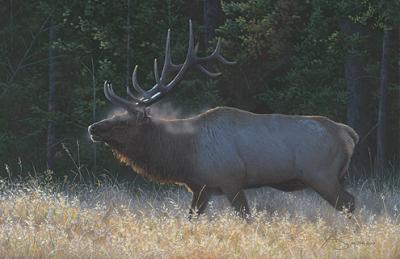
But, like many young men, in high school Adam’s interest turned toward cars, and like his father’s ability to focus, he turned his attention to it fully. He drew cars and dreamed of designing automobiles—despite placing first in the Montana Junior Duck Stamp competition at age 16.
“I did that just to see if I could paint,” he laughs.
After high school he earned a degree in automotive technology and an associate’s degree in business from the Wyoming Technical Institute, then returned to Bozeman where he could enjoy snowboarding and work as a line-tech mechanic. Adam was 22 when he asked to borrow one of his father’s photographs of a lion. When he showed the painting of it to Dan, his father was amazed and thought it almost looked as if he had painted it himself. With a dedication that mirrors his father’s around that same age, Adam began putting all of his spare time outside of work into his painting. Auto technology, like the guitar, became a part of Adam’s past.
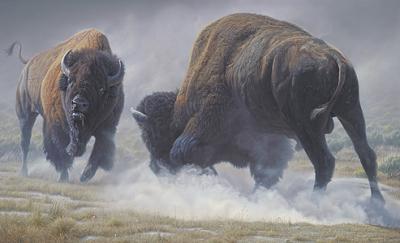
He also asked for his father’s advice. Dan said, “Don’t do it for the money. Do it because you love it.”
It would not have been surprising for the young artist to resist painting wildlife in order to pull away from his father’s reputation, but there was no need for Adam to do that. His passion was as evident as his gift, and he honed his skills by painting a great, gray African elephant next. Both lion and elephant were soon accepted—and sold—by Decoys & Wildlife Gallery in Frenchtown, New Jersey. Doors may have opened because of his father’s connections, but as Dan quickly points out, Adam’s work wouldn’t be in the galleries unless it was worthy and recognizable as his own.
Both Smiths paint in acrylics, and both paint wildlife with exceptional realism. They travel together to Yellowstone National Park to observe and photograph buffalo, wolves, birds, and bears, and last year Adam took his first trip—Dan’s seventh—to Africa. As they present images of their work, they banter easily about whether or not Adam has successfully painted a bear standing in water.
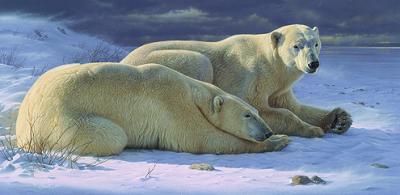
“That’s Dad’s thing; he’s got that down,” Adam says.
“No, you’ve done one, too, and it was good,” says Dan.
Although both artists prefer the clarity and fluidity of acrylics, Adam muses that he is starting to think about exploring in oils. “I have some ideas about things I want to try.”
At a casual glance, the untrained eye might not distinguish between Dan and Adam’s work, but as Adam’s career deepens, that could change. Adam’s process is less methodical than Dan’s, yet his backgrounds tend to be more developed. Dan intentionally creates calmer backgrounds that allow the intensity of the animal and the light to draw the viewer in without distraction. Adam’s balance of composition combines more elements, including rich layers of grass, which Dan observes is one of the most difficult things to paint.
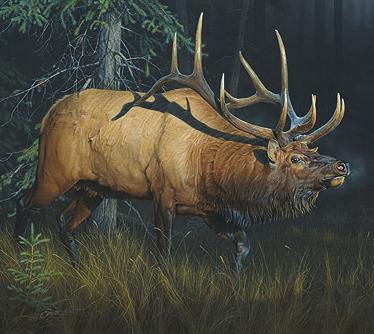
Despite the trips to Africa and the elk that pass outside Dan’s studio window, neither father nor son hunts. In part, they say, there just isn’t time. They speak highly of the value that tourism and hunting industries bring to Africa. Dan also says the time he has spent in some of the poorer areas has given him understanding of the villagers who “poach” in order to feed their families. He adds that after having spent time observing elephants closely, he couldn’t shoot one: they are too much like people.”
“I am blessed to do what I love every day,” Dan says. Or was it Adam? More than artistic instruction, it appears Dan’s best fatherly advice has been on how to live well and embrace the discipline to fully realize one’s talents. Undoubtedly, this commitment has laid the foundation for each artist to create memorable, lasting images of the wildlife that help to define and ennoble our existence.
It is as Chagall has said: “Great art picks up where nature ends.”

Daniel Smith
Safari Club International in Reno, Nevada
Masters of the American West Fine Art Exhibition and Sale
at the Autry National Center in Los Angeles, February
American Miniature Show at Settlers West Gallery
in Tucson, February
American Masters at SCNY, Salmagundi Club,
New York City, NY, May
Salute to Summer Show at Trailside Galleries in Jackson Hole
Prix de West Invitational Art Exhibition and Sale at the
National Cowboy & Western Art Heritage Museum in Oklahoma City, June
27th Annual Fall Classics Show at the Ponderosa Art Gallery
in Hamilton, Montana, August
Quest for the West Art Show and Sale at the Eiteljorg Museum
of the American Indians and Western Art in Indianapolis, September
Western Visions Miniatures and More Show and Sale,
National Museum of Wildlife Art, Jackson Hole, WY, September
Fall Gold Show and Holiday Miniatures Show at Trailside Galleries in Jackson Hole
Great American West Show, Settlers West, Tucson, AZ, Nov.
Miniatures Sale and Auction at Collectors Covey in Dallas, TX, Nov.
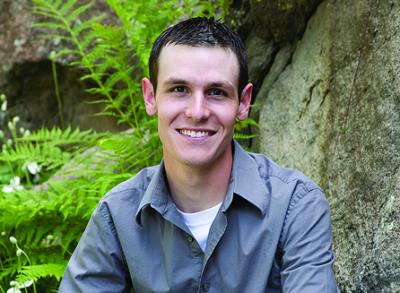
Adam Smith
Safari Club International in Reno, Nevada
Small Paintings Spring Show at Decoys and Wildlife
in Frenchtown, New Jersey
Salute to Summer Show at Trailside Galleries in Jackson Hole
27th Annual Fall Classics Show at the Ponderosa Art Gallery
in Hamilton, Montana, August
Western Visions Miniatures and More Show and Sale,
National Museum of Wildlife Art, Jackson Hole, WY, September
Fall Gold Show and Holiday Miniatures Show at Trailside Galleries in Jackson Hole.
Miniatures Sale and Auction at Collectors Covey in Dallas, TX, Nov.
To stay current on the work of the Daniel and Adam Smith,
sign up for their newsletter:
Animal Palette (since Fall 2008, quarterly,
Of course,Savannah Barnes has a Border Collie, drives a 4WD, shoots (and butchers) elk, teaches yoga, writes educational curriculum, and holds down a day job with a software company.
This is Montana.

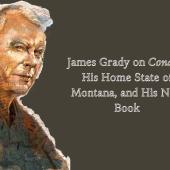
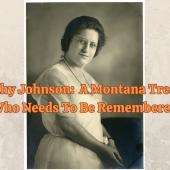


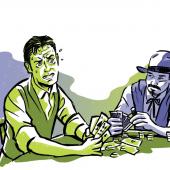
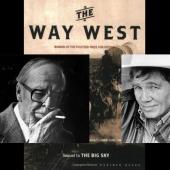





Leave a Comment Here